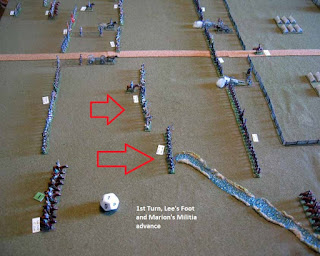My last solo run of this battle
got the following comment from Jeffers,
“The Firing rules confuse a lot
of people. It is meant to represent long range fire only, basically long-range
pot shots. Close Combat is not melee or hand to hand: it includes close range
firing. It’s better to get stuck in sometimes as good quality troops will
easily shake off this nonsense; close combat has a good chance of causing
damage, even if you lose.”
It being well over a decade since
we last used Loose Files, I decided to try the battle again with this in mind.
I also put Pickens and Marion in as unit leaders (a scenario rule), and based on Novack’s OB gave
the Americans a section of light artillery. A deployment map was discovered
that showed Lee’s Legion foot deployed next to Marion’s militia, so that was
done too. A number of events interfered with the game as will be seen below.
But Jeffers’ comments were worthy of note.
Previously I thought Loose Files needed a few house rules. Now I think it needs clarity. Who is in combat, especially when units are different sizes in a game of linear formations? And when more than one per side is involved, what are the losses? In the case below, Marion and Lee’s Legion Foot attacked the 64th and supporting artillery. Marion’s left was within 4” (combat range) of the Loyalists. So, I included that whole unit, which skewed the odds heavily against Marion and Lee. The result was an easy victory for the Crown, get 1 DP. I gave both infantry units and the artillery section 1 DP each. The defeated loser gets 2 DPs and loses 2 casualties. Applied to both losing units, that was 4 DPs and 4 casualties. I wonder if the winners should get 1 DP only and the losers 2 DPS and casualties only. Hmm.
Pickens was hit but his boys proved that they had what it takes.
Another lesson: don’t let enemy artillery approach to within canister range. The Loyalists are about to get hosed.
I had stopped the game after turn
5 to prepare dinner, a grilled ribeye, roasted veggies, Bordeaux and my wife’s
company. During turn 6, a dear friend called, upset over the state of the nation.
It took a while to calm him. Can’t blame him.
That’s my excuse for making the
combat error. Looking at it today, I didn’t have the will to figure out what to
do about the error to continue and decided to write this up instead. The
British center is like Swiss cheese at this point. If Campbell’s Virginia
Continentals can double-time without getting too disordered, they could smash
the center wide open. Again, if Washington’s Dragoons hadn’t been fiddling
around. Would-a, could-a, should-a…
I played 6 turns in about 90
minutes or so, not counting the breaks for dinner and phone call. Crown losses
so far were 5 stands of regulars, 3 of Loyalists, about 144 troops. Continental
losses were 4 regulars, 8 militia and 2 cavalry, about 240. I really have to
have a game of this whenever we get back to face to face gaming.
Again, I now feel the game needs fewer house rules and more house interpretations of the rules as written. Who is engaged in combat? And how are the penalties shared among multi-unit combats? I’ve already dispensed with orders, since they were mentioned one time and never defined. And threw out the cavalry changing speeds. The infantry doesn’t have to plan a turn in advance to attack, why should the cavalry? As it is, whenever I move cavalry, they roll a 2 and pick up disorder. Nothing in the rules, the dice gods just know.













6 comments:
Nicely done again. The Revolutionary troops seam to be the aggressors in each battle you tried ? Is that inherent in this scenario or your predilection?
This is the battle of Eutaw Springs. Greene's army attacked, capturing 400 British foragers before the battle started, the equivalent of 11 stands of infantry. They tried to go on and take the rest of the Crown forces.
I know what battle it is.I guess the answer to my question is , No the Americans don’t have to attack , but you wanted to reenact the fight As best as possible ,So you chose to do what they did.
I am trying to recreate the actual battle. Once 400 prisoners had been taken before the battle, the British would have been very happy if the Americans left them alone. Greene was trying to finish off the British army.
Enjoying these battles very much.
I especially like your comments on the rules. You are right, sometimes we try and add on so many additions or alterations to them we lose sight of his they really play. I am going back and rereading them and will also try them out again .
Your comments, and those of Jeffers have been outstanding and have gotten me rethinking how I play these rules. Thank you both!
Aw shucks, thanks.
Post a Comment